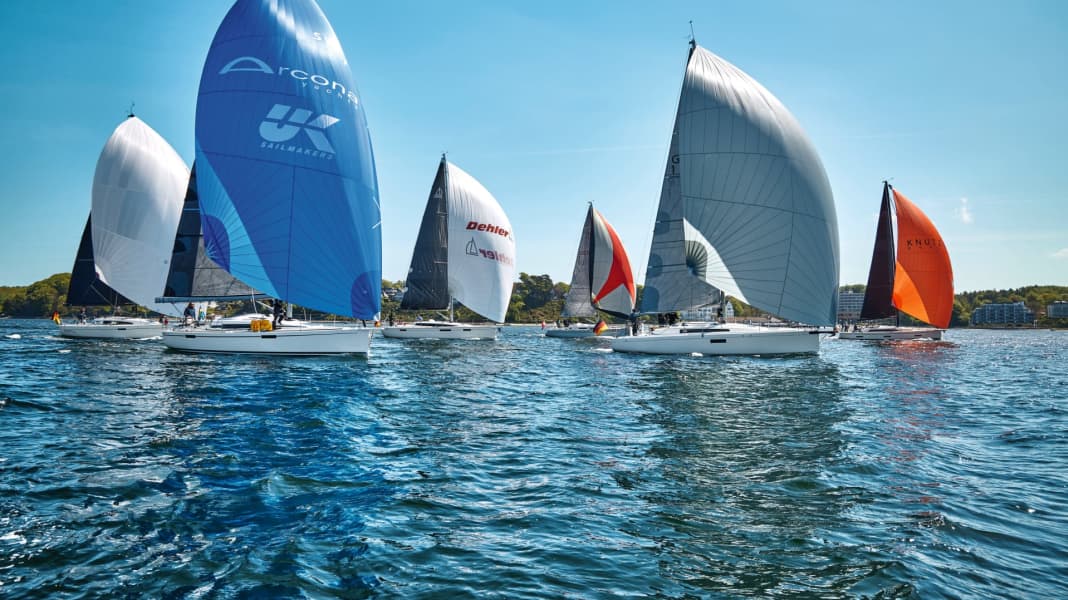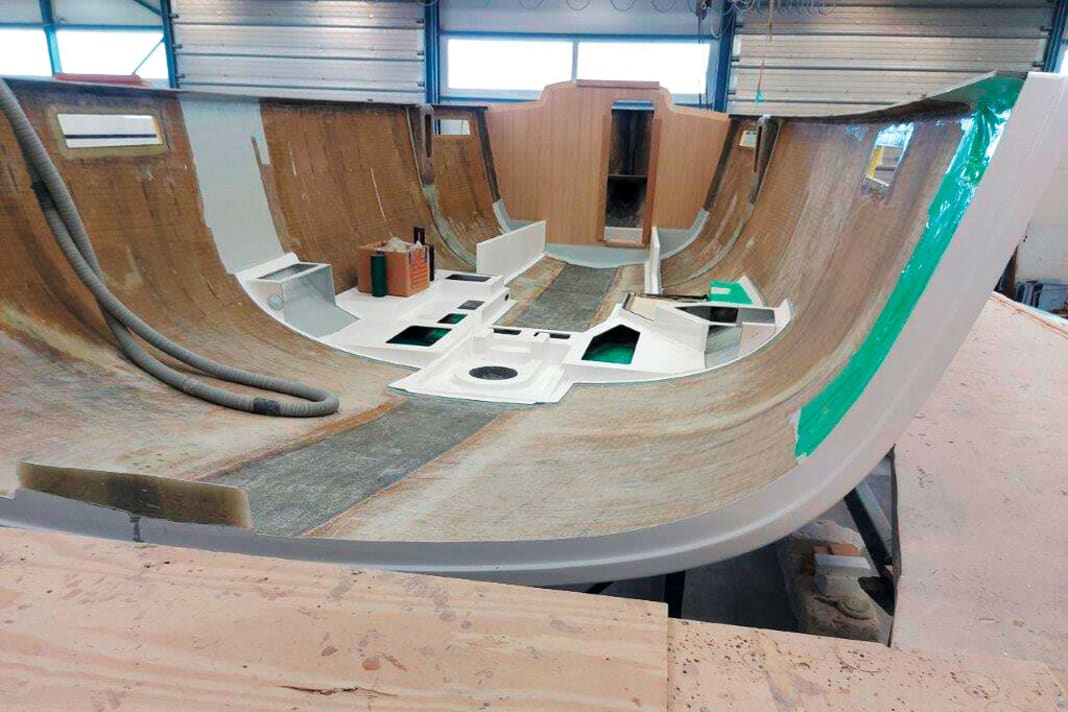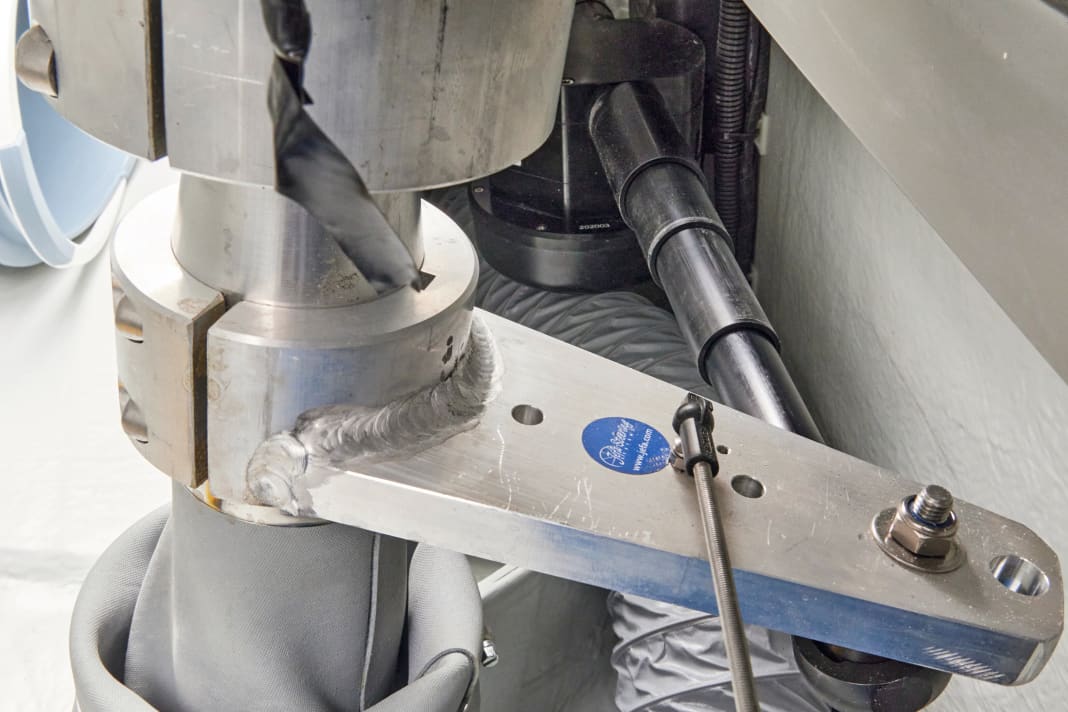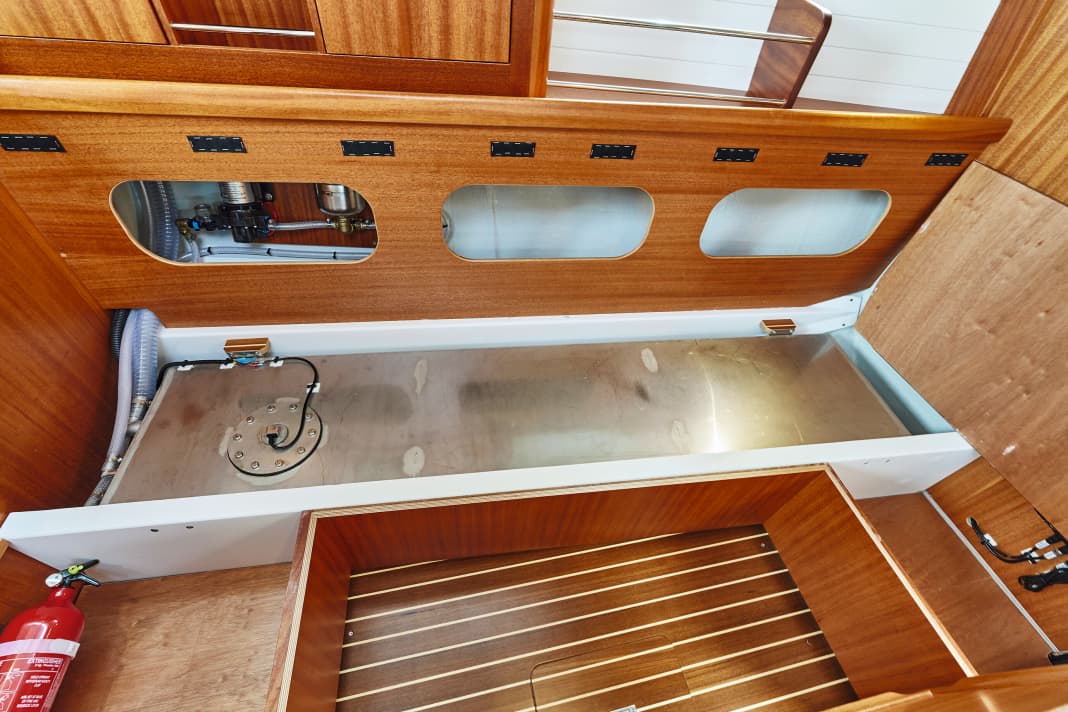Performance cruiser part 3: On-board technology, construction and build quality

In the test:
- Arcona 385
- Dehler 38 SQ
- Faurby 370
- First 36 from Beneteau
- J 112 E
- X 4.0
All parts of the performance cruiser comparison
The first and second parts of the big YACHT comparison test put the six performance cruisers to the test. They had to prove what they are capable of under sail, how they can be steered and operated, what comfort they offer below deck and the quality of the fittings.
For the third part of the group test in this issue, it's literally time to get down to business. The test subjects are now put through their paces below deck. The focus is on the technical components on board, their quality, workmanship and installation. Another topic is the built-in engines, access for maintenance and repairs, but also the manoeuvrability of the boats under engine in the harbour. And we show how the hulls and decks, the structural elements and the appendages are built.
Manufacture
There are two main construction methods for manufacturing the hull and deck. In conventional hand lay-up, fibreglass fabric and sandwich material in the form of rigid foam panels or balsa wood are inserted in layers into the open negative moulds and continuously impregnated with synthetic resin. In this test environment, the hulls and decks of the Dehler 38 SQ, the Faurby 370 and the deck of the X 4.0 are produced in this way. The hulls (hull and deck) of the First 36, the J 112 E and the Arcona 385, on the other hand, are produced using the much more complex vacuum infusion process. The hull of the X 4.0 is also built in this way. The glass fibres and the core material are first placed dry in the negative mould and the resin is sucked in under a plastic cover with vacuum pressure.






The significant advantage of the vacuum method is the controlled addition of a certain amount of resin. This enables shipyards to build lighter hulls and decks and also guarantee consistently stable hull weights. And because the resin infusion takes place in a closed system (vacuum film), the emission of styrene during the curing of the structures can be largely avoided. This is ecologically valuable and beneficial to the health of production workers, but also produces a large amount of plastic waste. The weights of hulls and decks produced using wet hand lay-up are generally somewhat higher.
In general, however, opinions regarding the quality, durability and strength of the two very different construction methods differ widely, even among experts. For this reason, we will refrain from a general categorisation and assessment within this test group at this point. Both methods have equal advantages and disadvantages.
On the Scandinavian-produced boats from Arcona, Faurby and X-Yachts, the shipyard also installs a galvanised steel frame to reinforce the floor assembly. These so-called strongbacks are intended to ensure that the forces from the rig and from the keel suspension are dissipated better and in a way that is gentle on the structure. In the Dehler 38 SQ, the First 36 and the J 112 E, the floor assembly is correspondingly stronger and manufactured in monolithic GRP construction, i.e. as a continuous and coherently manufactured component. In all three cases, it is manufactured outside the fuselage and only glued into the shell and additionally laminated afterwards. In the case of the First 36, the GRP furniture foundations also fulfil a structural load-bearing function.
There are also differing opinions regarding the efficiency and durability of hulls with steel frames. One widely held belief is that the different material expansions mean that the structures of the floor assembly are exposed to greater stress, which can lead to fractures at the transitions in the long term. Other opinions attest that steel frames are stronger and subject to significantly lower structural loads than ships with GRP floor assemblies. A good/bad assessment is therefore also difficult in this case.
The six test yachts differ in terms of keel design. On the Arcona 385, the J 112 E and the X 4.0, the fins are made of cast iron with a ballast body made of lead hardened with antimony bolted to the bottom. These keels are extremely effective with their high ballast content and low centre of gravity. In addition, the keel shaft of all three types is encapsulated in a GRP profile right from the shipyard. This ensures a consistent shape and perfect surfaces. The keels of the Dehler 38 SQ and the First 36 are made entirely of cast iron, without lead bodies and without special GRP sheathing. They have a lower ballast ratio and the keels are therefore somewhat less efficient. Once again, the Faurby 370 is the exception, with a keel shaft made of high-quality steel and a ballast bomb made of hardened lead. The keel fin of the Faurby is also enclosed in a GRP hull to optimise the profile.
The steering gear
The rudder blades on all boats are built as composite constructions made of GRP. The rudder shafts are made of aluminium as standard, with the exception of the J 112 E. On the French-built American, the rudder shaft is made of robust stainless steel as standard from the shipyard. The stainless steel shaft is also available for the Faurby and the Dehler, but only as an option for a corresponding surcharge. Stainless steel rudder shafts have advantages as they are very rigid and do not bend under high rudder pressure or collisions. The aluminium rudder stock, on the other hand, gives way more quickly under high loads, but the hull structures are more likely to remain intact in the event of a grounding, for example. And the aluminium shaft is lighter than the stainless steel shaft.
The First 36 is the only boat in the comparison with two rudder blades. For this reason, the steering mechanism must be considered separately because it is not comparable. The quadrants of the two rudder shafts are connected below deck with a push rod. The long, continuous control cable engages directly on the connecting rod and thus moves both control fins simultaneously. However, this system offers no redundancy in the event of a defect in the mechanics of the steering columns or the cable deflection. Two separate cables between the wheel and rudder on each side could guarantee more safety here, but they are complicated to install and often make the steering system sluggish. On the Arcona 385, the Dehler 38 SQ and the X 4.0, the rudder shaft is also only directly connected to the two steering wheels with one continuous wire cable each. These systems are not redundant either, but in all three cases they are particularly strong and of very high quality. The rudder shafts are mounted in self-aligning ball or nail bearings, and the quadrants on all three boats are oversized rather than undersized. This also applies to the J 112 E with its large, single steering wheel. Here, the steering cable's paths on the quadrants remain short, with little potential for slippage or unwanted friction.






The second special case in terms of steering is the Faurby 370. In the standard version, the slim Danish boat with its narrow cockpit is sensibly supplied with a simple tiller steering system in which the steering bar, the rudder shaft and the rudder blade form a fixed structural unit. Mechanical power transmission and redundancy are not an issue in this case. Similarly, the Faurby is the only boat in the test field to offer variance in steering. It would also be available with a steering wheel as an option.
The best way to access the controls on the First 36 is through the huge aft peak. This makes sense because the angle of attack of the double rudder blades can and often must be adjusted. The quadrant on the J 112 E is also perfectly accessible under a hatch on the aft deck or through the forecastle. Access to the steering cables and the quadrant is more complicated on the Arcona 385, the X 4.0 and the Dehler 38 SQ, where a bolted cover must first be removed to reach the cable deflections.
The machines
Performance cruisers in the eleven metre length class are generally equipped with built-in engines of around 30 hp with saildrive propulsion and a twin-bladed folding propeller. This generally seems to be the standard. In the test environment, this applies to the Arcona, Dehler, First (all Yanmar) as well as the J 112 E (Volvo Penta). The exception is the X 4.0, which is equipped with a more powerful 40 hp unit from Yanmar from the shipyard. This makes sense because the Danish vessel is not only the largest but also the heaviest in the test group. The Faurby doesn't fit the mould either. The shipyard only installs a 20 hp engine from Volvo Penta as standard. In her case, an upgrade to a 30 hp engine is the obvious choice, although this is possible but comes at an additional cost. The test boat was also upgraded accordingly.






Upgrades to more powerful engines with 40 hp are also offered for the Arcona 385 and the Dehler 38 SQ. The Swedes from Arcona Yachts are the only manufacturer in this competition to already offer a concrete and specified electric alternative for their 385. The Oceanvolt system with Saildrive motor delivers 15 kW, which corresponds to a diesel equivalent of around 45 hp. The surcharge for the electric drive at Arcona, including battery bank and control system, is around 32,000 euros, which is quite steep and makes you think twice. However, the other brands in this comparison do not completely ignore the topic of electric drives either. All shipyards are currently working quite intensively on corresponding offers for their ships.
In tests on the water and in the harbour, the Arcona 385 shows the liveliest manoeuvrability under engine. It produces immediate reactions with only a little thrust and can be turned easily and lively in the smallest of spaces. The J 112 E is also easy to manoeuvre under engine and demonstrates good response behaviour both when accelerating forwards and backwards. The Dehler 38 SQ, which is somewhat heavier in comparison, requires a little more time and more thrust for acceleration, but then also reacts without delay to the rudder deflections. This also applies to the X 4.0 despite the more powerful engine with 40 hp.

Due to its design, the reactions of the First 36 are somewhat sluggish when accelerating forwards because the two rudder blades are not directly affected by the engine thrust. It takes longer for the boat to react to the rudder and it needs more speed to do so. On the other hand, the reactions when accelerating backwards and turning in are all the faster and more powerful. With its tiller steering, the Faurby is light and easy to manoeuvre in the harbour, and it also reacts very well. However, you have to hold the tiller very tightly when manoeuvring backwards to prevent it from breaking out to one side, which can be fatal for people and equipment - one of the few disadvantages of tiller steering. Careful handling of the throttle is definitely a must here.
Because engines need to be checked and serviced from time to time and, in the worst case, even replaced, accessibility is an important issue. This is where the Faurby 370 comes up trumps, as the companionway can be removed as a complete element, leaving the engine largely free. The saildrive is also easily accessible through a hatch at the rear. The engines and their most important components on the Arcona 385, the X 4.0 and the First 36 are also easily accessible from all sides through large inspection hatches.
The Dehler shipyard in Greifswald installs the saildrive in front of the 38 and not behind it, which is not entirely unusual for reasons of weight management. The disadvantage: the engine is difficult to reach from the front due to the folded-up companionway; only the inspection hatches at the side provide access. However, these are also quite large. The engine room of the J 112 E is quite cramped. Although the components are accessible, there is a lack of space for maintenance and replacement. On the other hand, the large hatch in the aft cabin for particularly good access to the saildrive is a positive feature.
The tanks
In terms of tank capacity, the X 4.0 and the Dehler 38 SQ are ahead of the game. They offer significantly more storage reserves for diesel (180/160 litres) and fresh water (270/295 litres) than their competitors. On the Faurby 370 in particular, however, the filling quantities are tight, with a maximum of 64 litres of fuel and 110 litres of fresh water.






Fresh water as standard. Of course, the Faurby shipyard is also very flexible in this respect and can also install larger storage tanks on request and where possible. On the Arcona 385, all tanks on board (including black water) are made of stainless steel. Stainless steel tanks are also an option on the J 112 E for fuel and on the Faurby in general. On the X 4.0, the diesel tank is made of aluminium, which is rather unusual but standard on X-Yachts.






In the test field, the electrical installations are well done, the cables are neatly and clearly laid and labelled where necessary. The Arcona 385 once again came out on top in this respect, scoring points for the technical installations in general. The J 112 E, on the other hand, falls behind, as the electrical cabling in particular is laid rather carelessly in places and some of the cables are only roughly attached with hot glue.






Conclusion
The interim conclusion after the third part of the comparison test: The six yachts also combine many advantages and disadvantages in terms of construction methods, technology, equipment and workmanship. This continues to make it difficult to determine a clear test winner. The jury is still out. Find out how it turns out in part 4.
All parts of the performance cruiser comparison
Here is the video to the article

